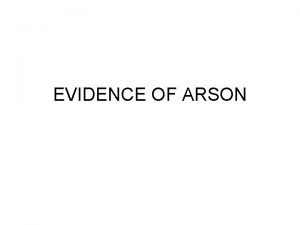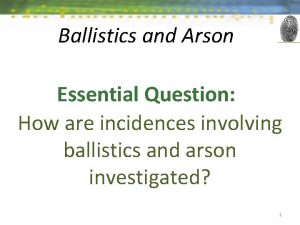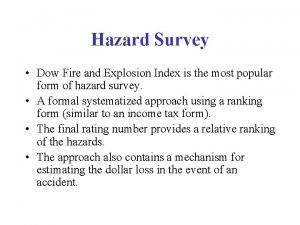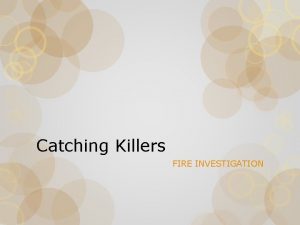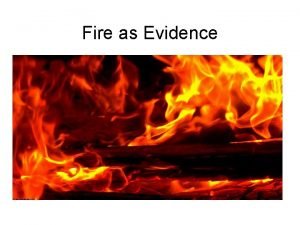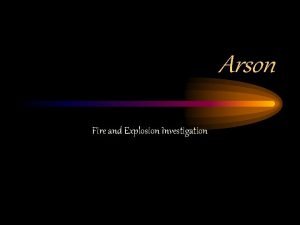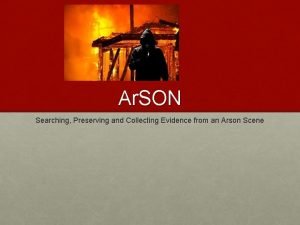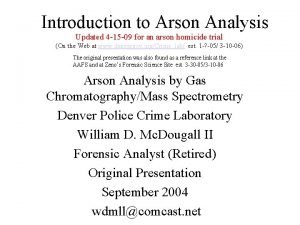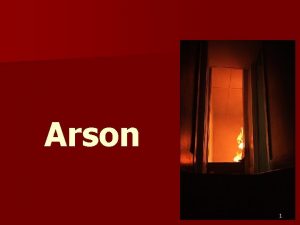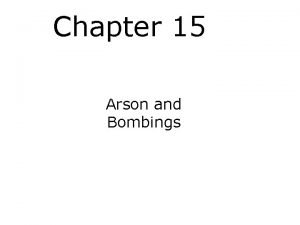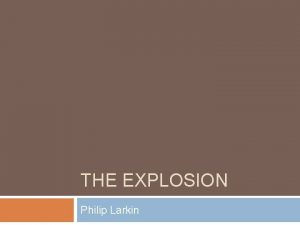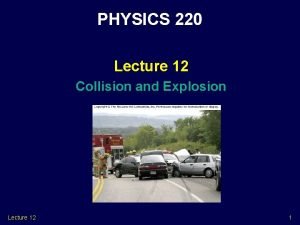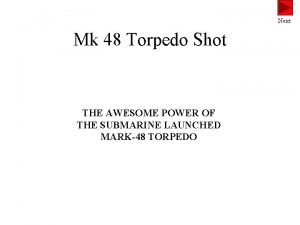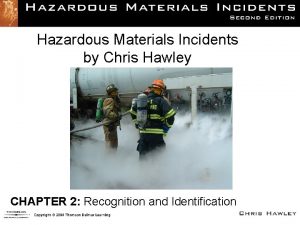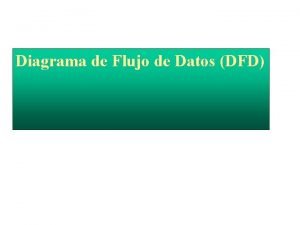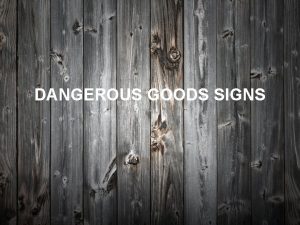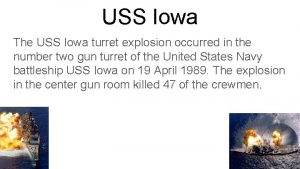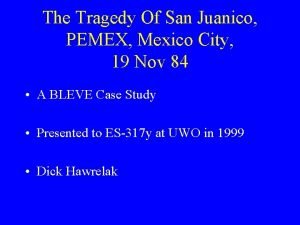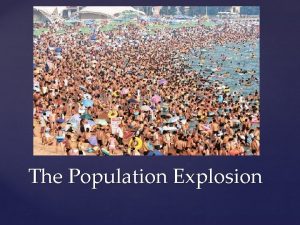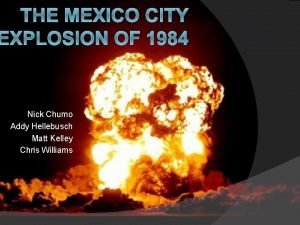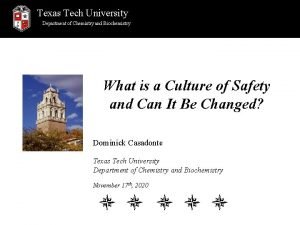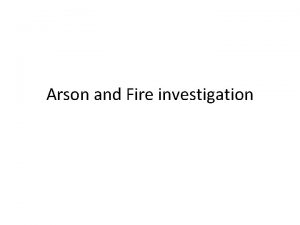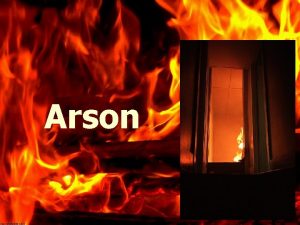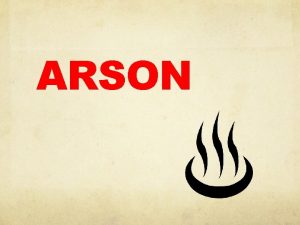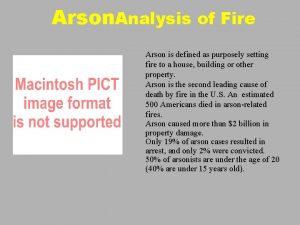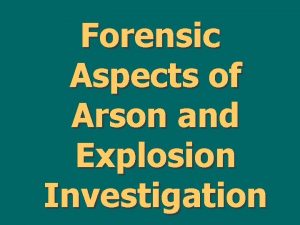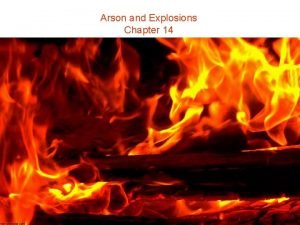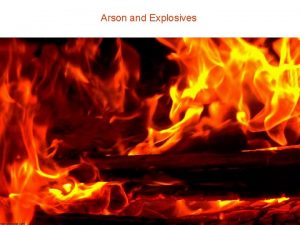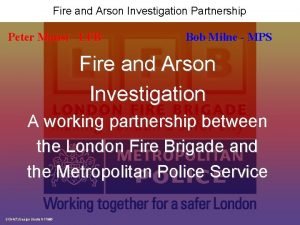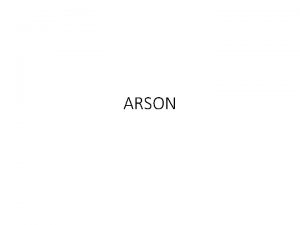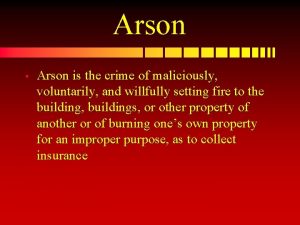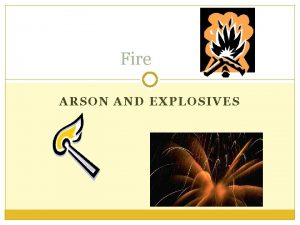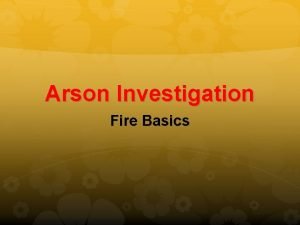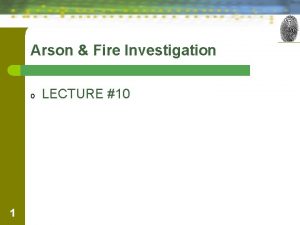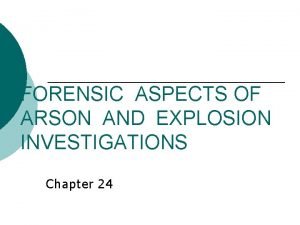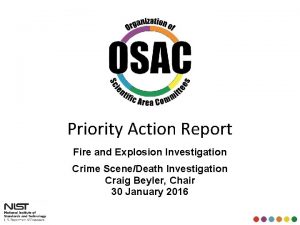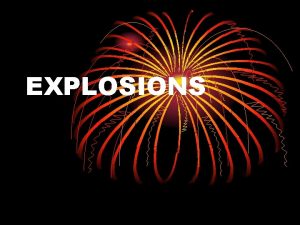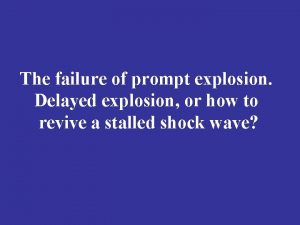Arson Fire and Explosion Investigation Arson Is one


















































- Slides: 50

Arson Fire and Explosion Investigation

Arson • Is one of the most difficult crimes to investigate for a number of reasons: – Usually planned and perpetrator has left the crime scene before the fire – Extensive destruction often makes gathering physical evidence difficult – Must establish a motive, the modus operandi (method), and a suspect – Must eventually have (in court) corpus delicti – have overcome the presumption of accident and have proved the ‘body’of the crime

Chemistry of Fire

Oxidation • Fire is actually a very rapid chemical reaction of the type known as oxidation • Simple description of oxidation is one of oxygen combining with other substances to produce new products • Not all oxidation produces fire

Oxidation Chemical Equation for the burning of Methane: CH 4(g) + 2 O 2(g) CO 2(g) + 2 H 2 O(g) Chemical Equation for the oxidation of Iron: 4 Fe(s) + 3 O 2(g) 2 Fe 2 O 3(s) rust

Energy • So why does gasoline not burn when left out in air – even when exposed to heat or sunlight? • Energy – the capacity for doing work • Chemical bonds between atoms in compounds contain potential energy • Often, molecules must absorb energy for their bonds to break • Also, molecules may give off energy when new chemical bonds form • If there is more energy given off in a reaction than is required to initiate it – exothermic reaction

Energy • The excess energy in these exothermic reactions may be given off as heat and/or light • The amount of excess energy given off per unit of the substance burned is called the heat of combustion

Energy of Activation • In order to start many oxidation reactions, energy must be added • This energy requirement is called the Energy of Activation • This energy can be supplied by heating the substance

Energy of Activation • Once the heat input exceeds the energy barrier, the reaction begins • the temperature required to ignite most common fuels (ignition temperature) is very high so often an outside source of ignition is needed (a spark)

Ignition • Once a fire starts, a sufficient amount of heat is liberated to keep the reaction going by itself – a chain reaction • The fire absorbs a portion of its own liberated heat in order to generate more heat • The fire will continue to burn until the supply of oxygen or the fuel runs out

Rate of Reaction • Although all oxidations liberate energy, not all produce a flame • Fire, like all chemical reactions, is caused by molecular collisions between the reactants – heat speeds these collisions • Also, a fuel will achieve a reaction rate with oxygen sufficient to produce a flame only when it is in a gaseous state – because molecules can collide more quickly than in liquid or solid states

Rate of Reaction • The flash point is the lowest temperature at which a liquid gives off sufficient vapor to form a mixture with air that will support combustion • Eg. Gasoline had a flash point of – 50 o. F but has an ignition temperature of 495 o. C • The flash point is always lower than the ignition temperature

Pyrolysis • Solid fuels (like wood) will burn only when it is exposed to heat that is hot enough to vaporize the wood into gaseous products – called pyrolysis • Again, an ignition source is often needed to initiate this process, but once begun, the reaction produces enough heat to maintain the reaction

Mixtures • The fuel-air mix must also be within limits for a fire to occur • If there is too much fuel and not enough oxygen (rich) – no fire will occur • Likewise if there is too little fuel (lean) the fire will not occur • The concentration range between the upper and lower limits is called the flammable range

Glowing Combustion • Some fires burn without a flame – smoulder • In these fires the heat is not sufficient to pyrolyze the fuel • This often ensues long after the flames have gone out • Wood burns its carbonaceous residue after the initial fuel has been exhausted

Spontaneous Combustion • Rarely cause fires – but is possible • Natural heat producing processes like fermentation and oxidation can produce enough heat to reach the ignition temperature • Rags soaked in linseed oil, grain or hay in piles (especially if exposed to sunlight or other heat sources) may burst into flame without an apparent ignition source • Hydrocarbon oils are not sufficiently volatile to spontaneously combust without significant outside heat input

Summary – Chemistry of Fire Three requirements must be met if combustion is to be initiated and sustained: 1. A fuel must be present 2. Oxygen must be available in sufficient quantities 3. Heat must be applied to initiate the combustion and sufficient heat must be generated to sustain the reaction

Searching the Fire Scene

Origin of the Fire • Although it is tempting to clean up after a fire, the scene must be immediately investigated – accelerants may evaporate quickly and valuable evidence may be removed • The origin of the fire is often the lowest point that the fire reached • Many exceptions to this due to falling floorboards, drafts and stairways may allow fire to spread downward from its origin

Tell-tale Signs of Arson • Once found, investigators usually concentrate their attention on the point of origin • Investigators often begin to suspect arson when they notice separate or unconnected fires in different areas of the building, the presence of ‘streamers’ (substances designed to spread the fire from one area to another • Discarded containers of accelerant and/or odor of accelerant • The presence of ignition devices (everything from a candle to a time-delay device)

Sniffers • Most often used accelerants are gasoline and kerosene • Only under the most intense conditions will flammable materials be completely consumed in a fire – some may seep into porous surfaces such as wood, upholstery, plaster or carpet • Evaporation of these fluids is often slowed when the fire is extinguished with water

A portable hydrocarbon detector – or ‘sniffer’ can detect volatile hydrocarbon residues Air is passed over a heated filament – if combustible material is present, the temperature of the air increases – meter moves


Burn Indicators • Evidence that helps fire investigators to determine the point of origin, temperature, duration, time of occurrence and the presence of flammable liquids are called ‘burn indicators’ • Few of these have had rigorous scientific testing, so they are often used more to help investigators than as evidence in court

Alligatoring • The checking of charred wood, giving it the appearance of alligator skin • Large rolling blisters indicate rapid, intense heat • Small, flat alligatoring indicates long, low heat

Depth of Char • This is the depth of burning of wood • Used to determine the length of burn and there by locate the point of origin of a fire

Line of Demarcation -the boundary between charred and uncharred material is the line of demarcation -On floors or rugs, a puddleshaped line of demarcation is sometimes believed to indicate a liquid fire accelerant -A sharp, distinct line of demarcation on wood indicates a rapid, intense fire

Crazing • Crazing refers to the cracking of glass into smaller segments or subdivisions in a irregular pattern • The extent to which glass will crack or craze is related to the type of glass involved, the thickness or the glass, the temperature range to which it was exposed, and its distance from the point of origin of the fire • Crazing into small segments suggests that the item was subjected to rapid and intense heat and/or that it was close to the point of origin

Pulled Light Bulbs • Incandescent light bulbs can sometimes show the direction of heat impingement • As the side of the bulb facing the source of heat is heated and softened, the gases inside a bulb of greater than 25 watts can begin to expand bubble out of the softened glass • This is not really ‘pulling’ because the gas is actually pushing on the glass

Sagged Furniture Springs Because of the heat required for furniture springs to collapse from their own weight (1 150 o. F) and because of the insulating effect of the upholstery, sagged springs are believed to be possible only in either a fire originating inside the cushions (eg. cigarette rolling between cushions) or an external fire intensified by fire accelerant

Spalling on roof of chunnel after fire Spalling • Masonry or cement may have a distinctive discoloration • In some cases the surface of these materials may be pitted and rough • This is because an intense fire may cause the moisture inside the brick or masonry element to convert to steam • As they expand, these steam pockets may burst through the surface of the cement or brick floor or wall

Freezing of Leaves • leaves in a forest fire may dry into their position at the time of the fire • Because leaves turn during the course of the day to face the sun, their position indicates the time of day the fire occurred • Some regard this evidence as unreliable because of winds generated by the fire

Collecting Evidence

Flammable Residues • Routinely, 2 -3 quarts of ash and soot debris must be collected at the point of origin when arson is suspected • This should include porous materials likely to contain flammable residues • Since these residues are subject to rapid evaporation and since petroleum products may react with plastics, airtight glass or metal containers are used to preserve evidence • In soil or vegetation, bacterial action may decompose accelerants, even in closed containers – in such cases freezing of samples will preserve them


Analysis of Flammable Residues • The gas chromatograph is the most sensitive and reliable instrument for detecting and characterizing flammable residues • The vast majority of arsons are initiated by petroleum distillates such as gasoline or kerosene • These liquids are actually complex mixtures of hydrocarbons • The GC can separate these components and produce a chromatographic pattern characteristic of a particular petroleum product



Refinements to GC • Using vapor from the ‘headspace’ of paint cans will collect some of the volatile hydrocarbon • If there is concern that there is very little residue present, heating the can and placing a charcoal coated strip in the headspace can trap much more of the hydrocarbon

Gas Chromatograph – Mass Spectrometer

Motives for Arson

Arson for Profit • The homeowner or business owner who decides to arrange an arson fraud may do so out of submission to financial stress • Usually two factors influence an insured person’s decision to commit arson fraud: – The desire for financial relief – Greed – desire for easily obtained financial assistance

Investigation of Insurance Fraud • Often involves a detailed analysis of the person’s financial situation • Some financial stress might not be immediately obvious (eg. Person is anticipating financial problems or has an illegal gambling debt)

Fraud Schemes • are sometimes plotted by professional criminals to defraud insurance companies, banks, or government programs of large sums • In New York, for example, older large buildings would often qualify for federal redevelopment funds • Fraud artists will buy these buildings and overinsure them, or partially redevelop them with cheap materials and then burn them for the insurance settlement

Other Motives • Other types of motives commonly encountered include – Elimination of business competition – Labor-management grievances (disgruntled employees) – Revenge, jealousy – feuding neighbors, jilted lovers, quarreling spouses – Vandalism, malicious mischief – set for excitement – Diversionary tactics – cover up evidence of murders, robberies, etc or to distract employees while a burglary takes place

Psychological Afflictions • Pyromaniacs differ from other arsonists in that they lack conscious motivation for their fire setting • Report an irresistible impulse to start fires and a sense of satisfaction after • Some are classified as psychotic – a severe form of personality disorganization characterized by marked impairment of contact with reality

Psychosis • Delusions, hallucinations, emotional blunting and bizarre behaviour may be present in a psychotic individual • In one study, 13. 3% of fire starters were classified as psychotic • Fires may be set for suicidal reasons, but may also be revenge and/or pyromania by the psychotic

Vanity or Hero Fires • On occasion the person who ‘discovers’ the fire turns out to be the one that started it • The motive may be to gain positive attention (hero) or to gain employment or excitement from fighting the fire (forest fire workers or even urban fire fighters)

Child Fire Setters • Repetitive fire setting by children is believed to be a severe behavior symptom or psychological disturbance • May be an outlet for vengeful, hostile reactions and/or defiance of authority • These children often lack security, love and attention in their home lives

Summary • Arson is a difficult crime to investigate because of the destruction of evidence by the fire • That said, there are many techniques that investigators use to determine if arson was the cause, and if so, how, when and why the fire occurred
 Ice lined refrigerator ppt
Ice lined refrigerator ppt Burned fire scientist questions arson
Burned fire scientist questions arson Dow fire and explosion index
Dow fire and explosion index Catching killers fire investigation
Catching killers fire investigation Forensic science arson activity
Forensic science arson activity Line of demarcation fire
Line of demarcation fire The boundary between charred and uncharred material.
The boundary between charred and uncharred material. Arson pour patterns
Arson pour patterns Arson
Arson Inverted cone fire pattern
Inverted cone fire pattern David berkowitz arson
David berkowitz arson Generic structure of news item
Generic structure of news item Why is arson considered a low priority crime
Why is arson considered a low priority crime One face one voice one habit and two persons
One face one voice one habit and two persons Reichstag fire who was the fire starter
Reichstag fire who was the fire starter Damper fire alarm
Damper fire alarm Fire hose reel signage standards
Fire hose reel signage standards Rwi are
Rwi are Race fire
Race fire One god one empire one emperor
One god one empire one emperor One one one little dog run
One one one little dog run One king one law one faith
One king one law one faith Byzantine definition
Byzantine definition One ford plan
One ford plan See one do one teach one
See one do one teach one See one, do one, teach one
See one, do one, teach one See one do one teach one
See one do one teach one One vision one identity one community
One vision one identity one community One vision one identity one community
One vision one identity one community Larkin the explosion
Larkin the explosion What candy is two female pronouns
What candy is two female pronouns Evangelism explosion outline
Evangelism explosion outline Population explosion refers to
Population explosion refers to A freight train is being assembled in a switching yard
A freight train is being assembled in a switching yard Torpedo 48 shots
Torpedo 48 shots Thinking routine step inside
Thinking routine step inside Dmc cladding
Dmc cladding Mass explosion hazard placard
Mass explosion hazard placard Georg grosz explosion
Georg grosz explosion Population growth factors
Population growth factors Share jesus without fear outline
Share jesus without fear outline Diagrama de flujo sobre el area de un triangulo
Diagrama de flujo sobre el area de un triangulo Tdg class 1 signs
Tdg class 1 signs Kendall truitt
Kendall truitt Hcsae pemex
Hcsae pemex Population explosion
Population explosion Bleve mexico city 1984
Bleve mexico city 1984 Ttu chemistry department
Ttu chemistry department Conceivable in a sentence
Conceivable in a sentence Overpopulation psa
Overpopulation psa Blob
Blob
